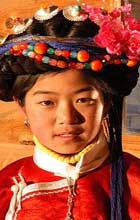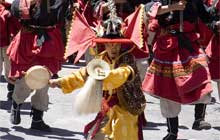
 History
History
The Naxi are one of China 's 56 recognized ethnicities, and although they have lived on the edge of the Chinese empire for centuries they have preserved many remarkable features of their culture. Some say the Naxi are descended from a group of people known in Chinese historical texts as the Qiang, whose homeland included parts of the Tibetan Plateau as well as the western areas of Sichuan and Yunnan . The situation is complicated as there is still a recognized Qiang ethnic minority in Sichuan . All this really goes to show is that the Chinese attempt to provide categorical definitions of who is and who is not a minority ethnicity, and where the lines between different ethnicities can be drawn, is a thankless and sometimes impossibly misleading task. In the early history of Naxi Lijiang, the area was pressed on all sides – to the south was the strong and aggressively expansionist non-Chinese state known as Nanzhao which was run by some combination of the Bai and Yi peoples; west of course lay the flourishing Tibetan empire at one of the strongest periods of its existence; while to the north-east were another group of Yi people, who also spent much of their spare time raiding their neighbors. While contacts with the Chinese proper have waxed and waned, the area only became formally integrated into the Chinese empire in the eighteenth century. For this reason perhaps there are a number of remarkable features of Naxi culture which have survived intact down to our day, they include language (especially the curious written forms), religious practices, music, and a reputation as being the sort of matriarchy that is somehow heaven for men.
The Naxi language belongs, appropriately enough considering that it is sandwiched between China and Tibet , to the Lolo-Burmese group. This group is a subset of a subset of the large Sino-Tibetan family which naturally includes Chinese and Tibetan. The Naxi also have their own written language comprising around 1500 pictographs. Like Chinese it is traditionally written top to bottom, but unlike Chinese it reads from left to right. It is not known when the writing first came into use but some estimates put it back at least a thousand years. It is not only, as one might surmise, limited to agricultural or trade uses – but has long been an integral part of the religious ceremonies conducted by the dongba, or local priests (and for this reason is known in Chinese as 'dongba writing' – although there is a newer modified form called 'geba writing' which is more a syllabary than a collection of pictographs, it also incorporates a Chinese influence).
 Religion
Religion
Religion in the area is quite complex. As you would expect from a culture that borders so many others there is not a single faith or belief to the exclusion of others. Underneath many beliefs is an unsurprising animism, and then there are forms of Buddhism, of Taoism, of Tibetan Bon, and in recent times some Christianity. Most people are connected with what is called Dongba religion (once again named after the priests). The cultural anthropologist Emily Chao provides a succinct description of this and a related form of traditional Naxi religious activity:
The Naxi had two types of ritual practitioners who were often referred to as shamans: the dongba, often translated as "priest," and the sanba, translated as "shaman." Dongbas differed from sambas in that they acquired their skills through apprenticeships that required learning pictographic texts to be used in structured rituals. Dongbas usually inherited their professions and were always male. The role of sanba, open to both men and women, was not learned or chosen but resulted from a traumatic illness during which a channel communication with a spirit or god opened up. Aside from practicing purification and propitiation of the gods, sanbas do not follow standard or predictable sequences in their rituals. Neither the role of dongba nor that of sanba was prestigious, and it was often taken on by poor farmers seeking to supplement their livelihoods.
Traditionally shamans in the area wore cloth turbans, wielded swords or beat drums, and while doing so would chant their shamanic rituals in a whispered voice.
While the situation with religion is quite complex, it's the opposite with music.
Music
We defy you to find a Naxi person who does not enjoy singing or dancing. Since the 1980s traditional Naxi music has been increasingly recognised as an art form well worth cultivating and preserving. The comparative political relaxation of the 1980s made possible the resumption of minority cultural practices that had formerly been either frowned upon; discouraged as being backward and superstitious; or just outright banned. It was in this period that the famous Naxi orchestra initially began playing locally. Domestic and foreign tourists who came through in that decade were entranced, especially as the orchestra made a conscious effort to not 'modernise' their music, and the orchestra garnered a nation-wide reputation. This fame spread and in 1995 they undertook their first foreign concert tour, to critical acclaim. The orchestra comprises percussion, flutes, lutes, and pipes. While much of the music was borrowed from the Chinese several centuries ago the Naxi have made it their own, incorporating their own instruments and musical flourishes.
Matriarchy
Finally, a word about the sexes. Naxi men are well known for their laziness. Apparently, there are three ambitions for a Naxi man:
• Build a house
• Marry and have a son
• Bask in the sun
When they are not otherwise engaged, Naxi men enjoy hunting, raising birds, playing Naxi music and practicing calligraphy, a list that clearly shows a mix of traditional concerns (hunting) with Chinese influences (calligraphy, or pretensions to being a scholar). Naxi men use hawks in their hunting and previously they used to sit on the bridge parading their hunting hawks and watching the women walk by. Despite their much-vaunted reputation as a matriarchal society the truth is somewhat different. As a general rule young boys are allowed to be as naughty as they please, while girls help their mothers with the chores as soon as they are able. Furthermore, girls marry out, and kinship is reckoned from the father's side – making the whole social edifice appear a very male-friendly (if not wholly male-invented) form of matriarchy. The association of the Naxi with matriarchy seems to be an unfortunate consequence of another closely related ethnicity known in Chinese as the Mosuo, who do in fact practice matrilineal descent. The Musuo, who are based to the north-west of Lijiang, are classified by the Chinese authorities as belonging to the Naxi ethnicity, a categorization that the Naxi usually strenuously oppose.
One small piece of history – look for a missing index finger on the right hand of some elderly men. Apparently this indicates that they had no wish to be conscripted to fight for the Kuomintang against the Japanese in the late 1930s and early 1940s. The fight against the Japanese was another interesting chapter in the long-running story of a route which joined Lijiang with Tibet , a route which came to be known as the southern branch of the Tea and Horse Route .